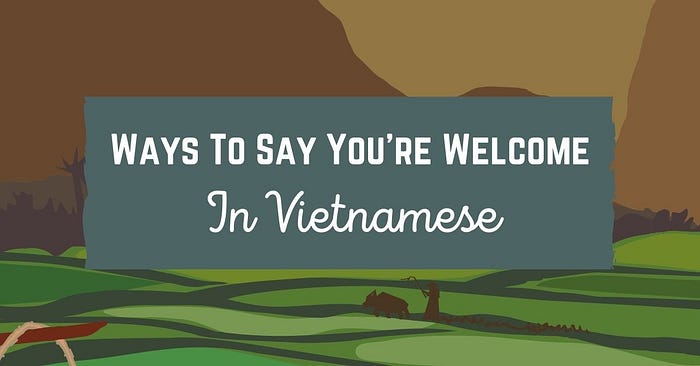Ways To Say You’re Welcome In Vietnamese

When you help someone do something, they will thank you to show their appreciation for your help. It is also a good practice that you respond in the language they speak. For example, when a Vietnamese person says ‘cám ơn’ (thank you!) to you, what should you respond to? Let’s learn some ways to say you’re welcome in Vietnamese today!
Most Common Ways To Say You’re Welcome In Vietnamese
The Vietnamese culture is group-oriented culture, which means that everyone should consider the group’s benefits first before each individual’s benefits. Helping people around you are also considered good behavior that everyone should always have. This explains why Vietnamese people don’t think what they helped you should be mentioned.
Let’s look at the most common ways to say you’re welcome in Vietnamese below.
Không Có Gì! — Nothing! (Northern Vietnamese)
‘Không có gì!’ is the common way to respond when someone thanks you in Vietnamese. It means ‘nothing’ in English. This phrase is used more frequently in the North of Vietnam.
For example, when you help someone order a cup of coffee, she will thank you and you will respond in Vietnamese as below:
Your friend: Cám ơn anh! (Thank you!)
You: Không có gì!
Không Có Chi! — Nothing! (Southern Vietnamese)
With the same meaning as ‘không có gì!’, ‘không có chi!’ is more popular in the Central and the South of Vietnam. People in the North also say this phrase sometimes because to them, ‘không có chi!’ sounds a bit cuter.
Other Ways To Say You Are Welcome When Someone Thanks You In Vietnamese
In a conversation with Vietnamese people, you may also hear them saying some other sentences to respond to ‘thank you!’.
Có Gì Đâu! — Nothing!
The phrase also means there is nothing to mention here, or don’t mention it!.
For example, when someone says that they really appreciate your help, you want to say that ‘Don’t mention it! Of course, I will help you, say ‘có gì đâu!’.
Ơn Nghĩa Gì! — It Isn’t A Big Deal!
‘Ơn nghĩa’ is a Vietnamese — Chinese word. ‘Ơn’ means ‘favor’, and ‘nghĩa’ means ‘meaning’. ‘Ơn nghĩa’ is a formal word. People usually use the word ‘ơn nghĩa’ to refer to a big favor or a big help.
If people say thank you in a very formal way (e.g. Cảm ơn anh nhiều lắm!), or show that they really appreciate your support, you will reply ‘ơn nghĩa gì!’ when you want to say that it isn’t a big deal.
Sao Phải Khách Sáo Thế? — Why So Formal?
‘Khách sáo’ doesn’t literally mean ‘formal’ but it is used to describe a formal behavior or response, which makes the listener feel that you are acting like you don’t know them well.
Some Vietnamese people say ‘sao phải khách sáo thế?’ (why so formal?) when they don’t want to you feel that you owe them anything because they helped you. It also means that they will definitely help you if they can.
OK, Uhm
‘OK’ or ‘Uhm’ are also used to respond when you know each other well. Don’t say these phrases to people who are older than you, have a higher social position than you, or people you are not very close to. Saying these phrases to respond to the mentioned people can be considered rude.
How Do You Respond To ‘Thank you’ Politely?
Tôi Rất Vinh Dự — It’s My Honor
This is a formal way to say that it is my honor to help you. It is usually spoken in a formal situation or in business. For instance, your manager mentions what your contribution has brought a great result to the company, you will respond by ‘tôi rất vinh dự’.
Tôi Rất Vui Khi Được Giúp Bạn — I’m Pleasured To Help
If you don’t know a person well, such as a new friend, you can say ‘tôi rất vui khi được giúp bạn’, which means ‘I’m pleasured to help’. The pronoun ‘tôi’ (for I) and ‘bạn’ (for You) can be replaced by other pronouns for I and You to make it more natural.
Remember to check my blog post for the Vietnamese pronouns and how to use them accurately.
Learn How To Say Thank You In Vietnamese
The most common ways to say thank you in Vietnamese are ‘cám ơn’ and ‘cảm ơn’. They are actually the same phrases but are pronounced in different tones. You can say ‘cám ơn’ or ‘cảm ơn’ in both formal and informal situations.
In a formal situation, you can express your gratitude by following phrases:
- Trân trọng cám ơn!
- Xin cám ơn!
- Xin đa tạ!
- Tôi rất cảm kích!
You can also learn some sentences to say thank you in different situations such as when you are promoted, or when you receive feedback from customers.
Let’s Practice You’re Welcome In Vietnamese And Thank You In Vietnamese Learn
Practice makes perfect. It’s very true in learning the Vietnamese language. I know that there are a lot of things to remember today. Let’s have a quick test to see if you remember what you have learned. Comment below your answers and I will get back to you with the correct one.
1) You and your classmate know each other for a long time. You sent her the notes for the lesson yesterday because she couldn’t join it.
Your classmate: Cám ơn cậu nhé!
You: ____________
2) In a company meeting, your boss said that he really appreciated your contribution in the last quarter. How will you respond to him?
If you enjoyed learning Vietnamese by practical examples, try out the Ling App. Thousands of users have learned Vietnamese with the app and they love its approach.
Original blog post: https://ling-app.com/vi/youre-welcome-in-vietnamese/
